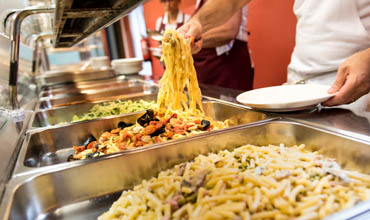
“Collective catering” means the preparation and delivery service for a large number of complete meals for the community, such as: company canteens, schools, hospitals, prisons, etc. It is aimed at groups of people who need to take advantage of this kind of service, as they are far from home for different reasons.
Collective catering is born as an adaptation to society: for industrialization, with workers originally employed in the factories, and then in the tertiary sector; for the transformation of the family from patriarchal to mononuclear; for the spread of canteens in schools from kindergarten to university; for health care; for the assistance community.
Collective catering is distinguished in a conventional system and a collective bond. As for the first, the foods are cooked and immediately distributed to consumers. In the second case, instead, the preparation and cooking operations and those of distribution and consumption are carried out in completely separate times and places. The preparation and cooking of the food is in fact carried out in large centers, from which the finished meals come out, which are transported to the canteens for distribution and consumption.

Consumers of catering, generally choose where to eat the meal, and make continuous and prolonged use of the service. In some cases the cost of the service is born by the company in which it is offered, in other cases the customer pays a part.
The collective catering is a catering of necessity, instrumental, not of pleasure; it focuses its attention on the realization and delivery of dishes, while the service is usually non-existent.
The main forms of catering are:
business catering: in medium or large companies;
school catering: within schools, universities, training centers;
socio-health catering: in hospitals, clinics, nursing homes and rest areas;
community catering: inside religious institutes, barracks, prison prisons;
assistance catering: intended for indigent people; it is organized in canteens but sometimes also with home service.
Each form of collective catering has specific needs, related to the type and needs of customers who must use it.
Careful attention must be paid to the nutritional and hygienic aspects, with constant quality standards that adapt to the changing and diverse needs of users. It is therefore proposed a standardized kitchen, but not without quality. Although less intense and pleasant taste and with a presentation of the dishes little attention, the cuisine of the collective catering is certainly very controlled and balanced under the nutritional aspect.
The menu is always the result of a work between chefs and nutritionists, often with the help of medical staff; each work phase is predetermined in every aspect, usually under the supervision of an expert in hygiene procedures and with a strong control of analysis laboratories.
In all this you must be very careful:
where to buy raw materials – collective catering companies have to buy large quantities of basic ingredients. These choose suppliers, who can be wholesalers or small producers paying attention to the value of food at Km 0, to the emerging buying groups and to the traditional general markets. So buying raw materials does not just mean buying large quantities of food from wholesalers, but also selecting a set of suppliers of different types, for products that are equally different in terms of quality and not just quantity.
Collective catering
how the menus are born – We must take into account today’s trends (vegans, vegetarians), be careful about people with food intolerances or allergies and finally respect the religious cultures of today’s society.

For this reason we talk about “menu programming” to take into account all these factors. For companies, the menus include the classic dishes of traditional Italian cuisine, prepared with seasonal products, as well as ethnic and international dishes. As for the school menus, the nutrition of the little ones is the most important.
how to prepare meals – this can be done in two ways: either inside the place where they will be served or with “conveyed meals”, this means that the preparation and cooking operations and those of distribution and consumption are carried out in times and separate places. The preparation and cooking of the food is in fact carried out in large centers, from which the finished meals come out, which are then transported to the canteens for distribution and consumption.
how to deliver meals – meal delivery is a logistics matter. We need to think beyond the time it takes to pack and secure meals, traffic and operations to prepare food to be served. It is necessary to be very attentive to the delicacy of the goods transported and above all to the cooking temperature of a food that comes out of the kitchen and that can not vary much compared to the time when it will be served for its consumption.
Read also: The rules for commercial catering


